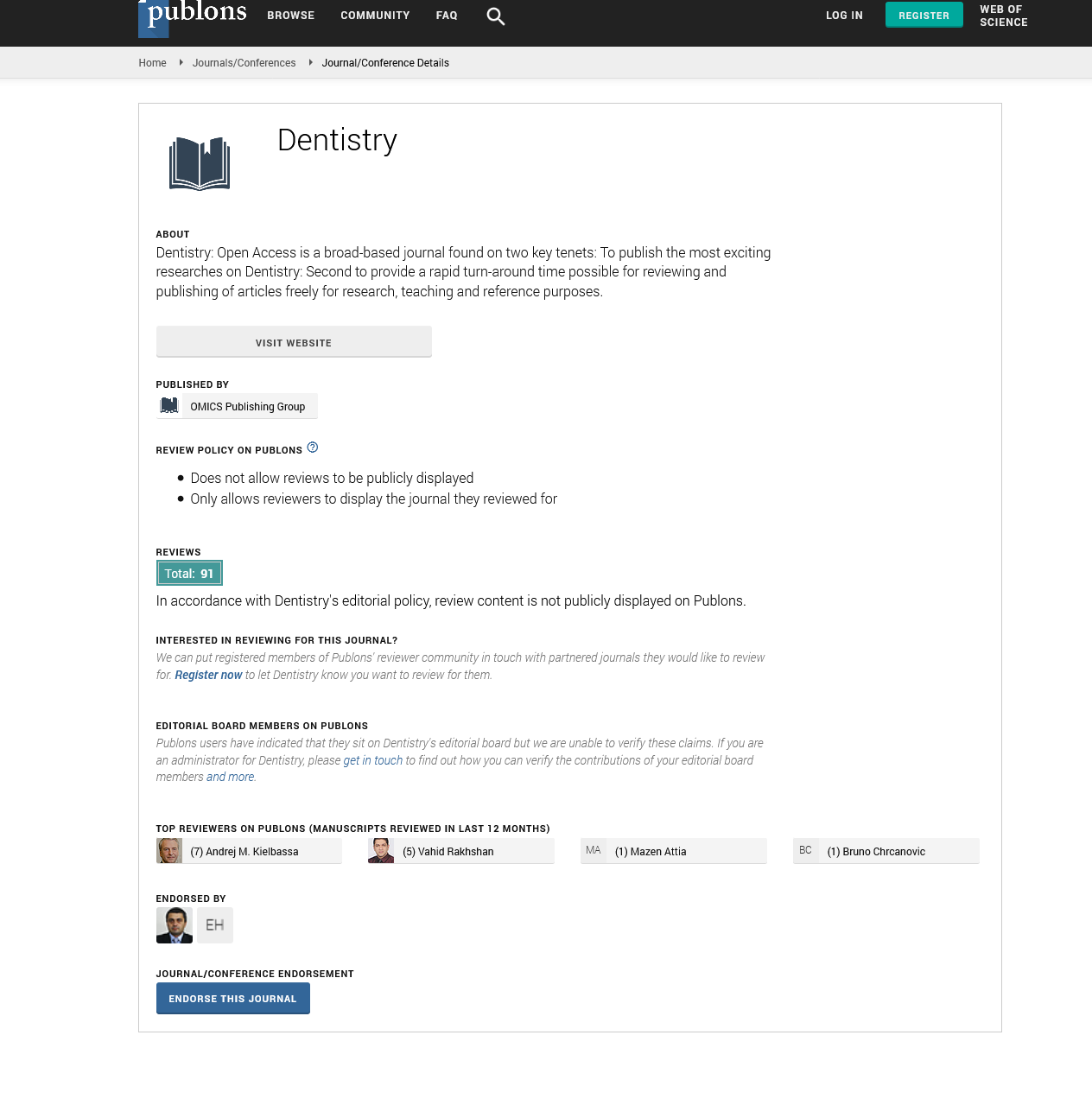Citations : 2345
Dentistry received 2345 citations as per Google Scholar report
Indexed In
- Genamics JournalSeek
- JournalTOCs
- CiteFactor
- Ulrich's Periodicals Directory
- RefSeek
- Hamdard University
- EBSCO A-Z
- Directory of Abstract Indexing for Journals
- OCLC- WorldCat
- Publons
- Geneva Foundation for Medical Education and Research
- Euro Pub
- Google Scholar
Useful Links
Share This Page
Journal Flyer

Open Access Journals
- Agri and Aquaculture
- Biochemistry
- Bioinformatics & Systems Biology
- Business & Management
- Chemistry
- Clinical Sciences
- Engineering
- Food & Nutrition
- General Science
- Genetics & Molecular Biology
- Immunology & Microbiology
- Medical Sciences
- Neuroscience & Psychology
- Nursing & Health Care
- Pharmaceutical Sciences
Opinion Article - (2025) Volume 15, Issue 1
Bone Regeneration in Direct Sinus Lifting with Immediate Implant Placement
Abdullah Azim*Received: 25-Feb-2025, Manuscript No. DCR-25-28555; Editor assigned: 27-Feb-2025, Pre QC No. DCR-25-28555 (PQ); Reviewed: 13-Mar-2025, QC No. DCR-25-28555; Revised: 20-Mar-2025, Manuscript No. DCR-25-28555 (R); Published: 27-Mar-2025, DOI: 10.35248/2329-9088.25.15.719
Description
Dental implant placement in the posterior maxilla often presents challenges due to insufficient bone height caused by maxillary sinus pneumatization and alveolar bone resorption. Direct sinus lifting has been developed to increase the available bone volume, enabling successful implant placement. Various techniques have been introduced, with trephine osteotomy gaining attention as a method that minimizes trauma and improves clinical outcomes.
Literature search and study selection
A systematic search was conducted across databases such as PubMed, Scopus and Web of Science to identify studies evaluating trephine osteotomy in sinus lifting procedures with simultaneous implant placement. Inclusion criteria consisted of clinical trials, retrospective studies and case reports that analyzed success rates, implant stability and patient outcomes. Exclusion criteria included studies lacking clinical follow-up or those involving indirect sinus lifting techniques.
Trephine osteotomy in sinus lifting: Technique overview
The trephine osteotomy technique involves using a trephine bur to create a circular bone window in the lateral wall of the maxillary sinus. The bone core can be repositioned or removed based on clinical preference. This approach allows for controlled elevation of the Schneiderian membrane, creating a space for graft material and simultaneous implant placement.
Preoperative assessment: Cone-Beam Computed Tomography (CBCT) is used to evaluate bone height and sinus anatomy.
Osteotomy preparation: A trephine bur is used to create a lateral window while preserving the sinus membrane.
Sinus membrane elevation: The membrane is carefully lifted to allow space for bone grafting.
Bone grafting: Autogenous or alloplastic graft material is placed within the elevated sinus.
Implant placement: A dental implant is inserted into the prepared site, ensuring primary stability.
Suturing and healing: The surgical site is closed and postoperative care is prescribed to optimize healing.
Clinical outcomes
Implant survival rates: Studies analyzing the trephine osteotomy technique have reported high implant survival rates ranging from 92% to 98%. The stability of implants placed simultaneously with sinus lifting procedures is comparable to those placed in native bone, provided that careful surgical planning is followed.
Sinus membrane perforation incidence: One of the primary concerns in sinus augmentation is membrane perforation, which can lead to complications such as sinusitis and graft failure. The trephine osteotomy technique, when performed with precision, reduces the risk of perforation compared to conventional lateral window techniques. The reported perforation rate varies between 5% and 12%, depending on the operator’s experience and the condition of the sinus membrane.
Bone regeneration and stability: Radiographic evaluations demonstrate successful bone regeneration in the augmented sinus cavity, with significant increases in bone height observed over a 6- to 12-month period. The trephine osteotomy method promotes stable bone formation, facilitating long-term implant success.
Postoperative complications: Complication rates associated with the trephine osteotomy approach remain low. Common postoperative concerns include transient swelling and minor discomfort, which typically resolve within a few days. Infection rates are minimal when appropriate surgical protocols and antibiotic regimens are followed.
Patient-reported outcomes: Patients undergoing sinus augmentation with trephine osteotomy often report lower levels of postoperative discomfort compared to traditional lateral window techniques. The reduced trauma to surrounding tissues contributes to improved patient experiences and faster recovery times.
Comparison with other sinus lifting techniques
Lateral window approach: The lateral window technique is a widely used method for sinus augmentation. While effective, it requires a larger bone window, increasing the risk of sinus membrane perforation and prolonged healing times. The trephine osteotomy technique provides a more conservative alternative, reducing surgical trauma and accelerating the healing process.
Osteotome sinus lift: Osteotome-mediated sinus lifting is another alternative, primarily used in cases with minimal bone deficiency. Unlike trephine osteotomy, this technique does not allow direct visualization of the sinus membrane, which can increase the risk of complications. Trephine osteotomy offers better control and predictability in sinus elevation procedures.
Advantages of Trephine Osteotomy
Minimal trauma: The circular osteotomy design reduces stress on surrounding bone structures.
Enhanced membrane preservation: Controlled access lowers the risk of perforation.
Simultaneous implant placement: Allows for immediate implant insertion, reducing treatment duration.
Predictable bone regeneration: Supports stable graft integration and long-term implant success.
Citation: Azim A (2025). Bone Regeneration in Direct Sinus Lifting with Immediate Implant Placement. J Dentistry. 15:719.
Copyright: © 2025 Azim A. This is an open-access article distributed under the terms of the Creative Commons Attribution License, which permits unrestricted use, distribution, and reproduction in any medium, provided the original author and source are credited.

